Comforting, hearty, and delicious, my Pappardelle Bolognese is the perfect dish to make when you’re craving big flavor. The ragu is slow-cooked, and since pappardelle is a more substantial pasta, it is the ideal match to the rich sauce. Serve with some crusty bread and a glass of red, and you’ve got yourself a truly epic meal.
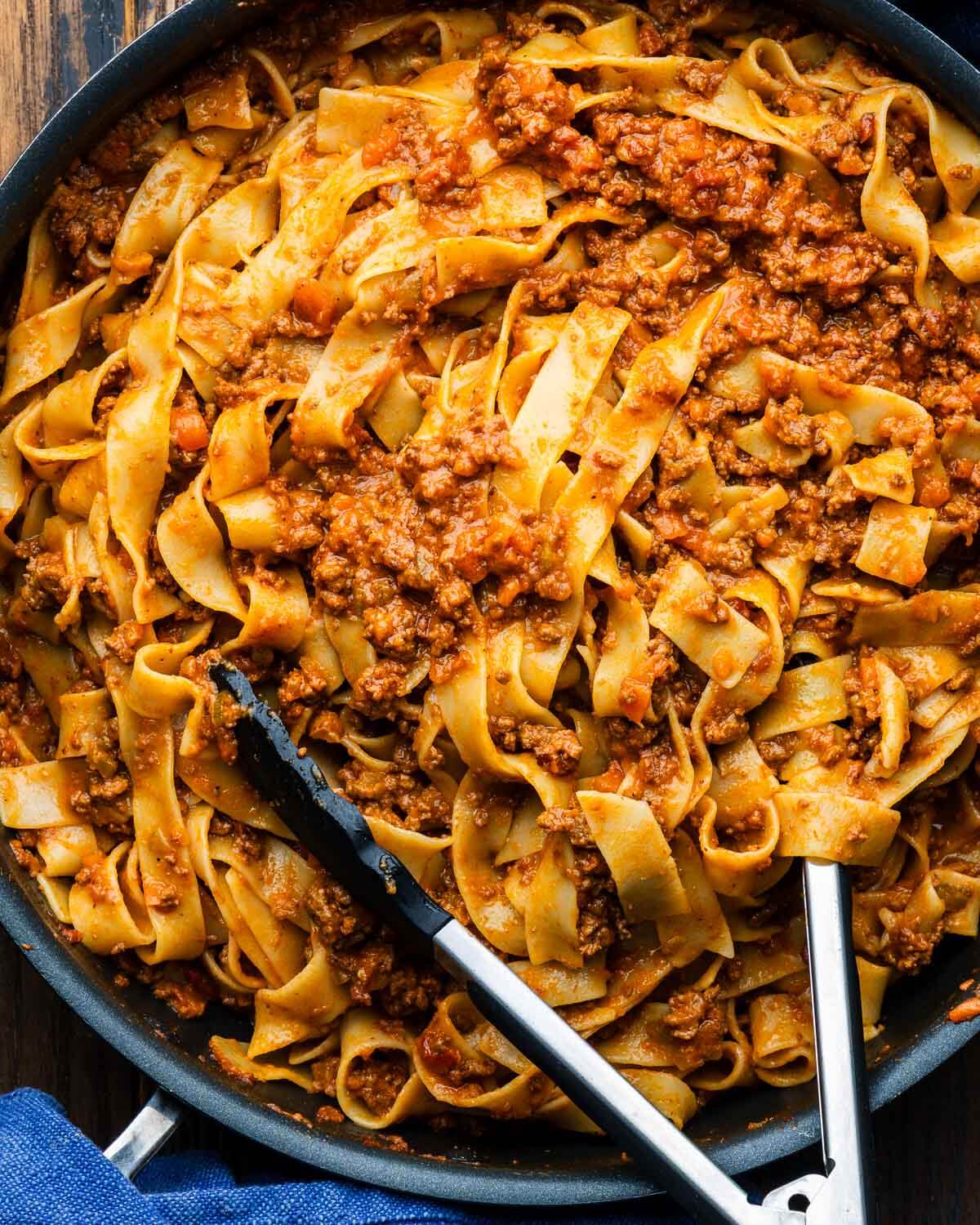
This post may contain affiliate links. Our disclosure policy.

I had to revisit this classic
Pappardelle alla Bolognese is a recipe I’ve had on my website for years now, and while my original recipe closely resembled the one set forth by the Bologna Chamber of Commerce (with the exception of beef stock), I felt the need to make a few tweaks now that I’m revisiting the recipe. I always encourage you to make recipes your own, and I’m following my own advice here.
While not much is changing, the subtle tweaks I’m making really enhance the flavor of my Bolognese ragù. For the recipe, I’m adding a few anchovies for more umami flavor, a rind of Parmigiano Reggiano to cook in the sauce, 2 bay leaves, and a pinch of nutmeg.
While Pappardelle Bolognese is something I could easily eat any night of the week, it’s especially good on Sunday since it needs a few hours to cook. Serve alongside your favorite greens, such as garlic sautéed broccoli rabe or garlic sautéed broccoli.
Recipe Ingredients
All ingredients for this recipe are shown in the pic below and special notes are made in this bulleted list to assist you.
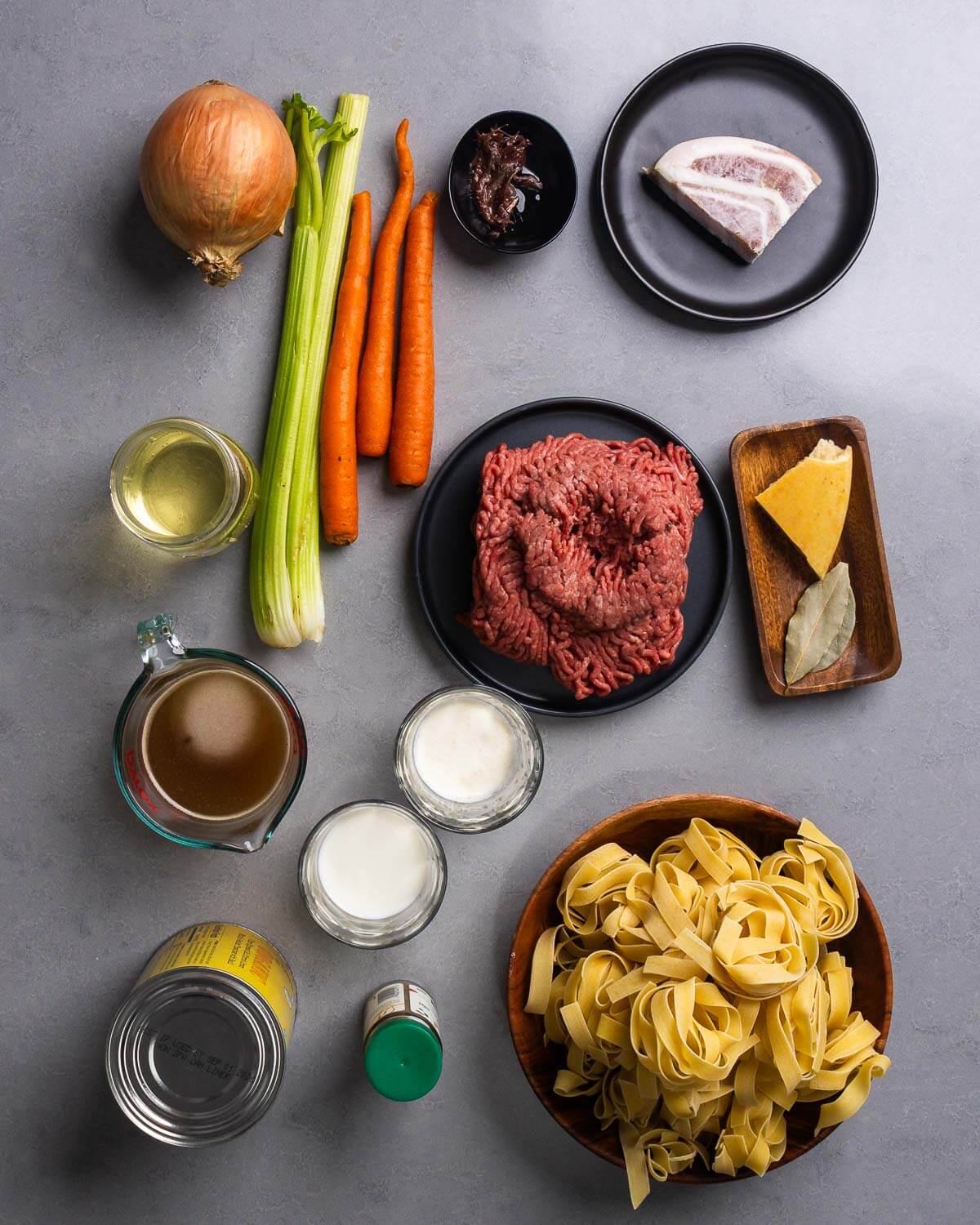
- Pappardelle. When it comes to hearty ragus, like my short rib ragu and ragu alla genovese , pappardelle, or other substantial pastas, such as tagliatelle or paccheri, are my go-tos. They do a better job of standing up to and holding a rich heavy sauce.
- Beef. I am using 80/20 ground chuck because that yields the most flavor. If you’d like to use a leaner beef, such as 90/10, you can do that. You can also use half beef and half pork if desired.
- Pancetta. This uncured, unsmoked pork belly is an important ingredient in authentic Bolognese and one I like to use for my version. If you have access to Italian specialty stores, you can often find at the deli counter, and some grocery stores will sell it already cubed. If you can’t find pancetta, you can use a neutral flavored bacon or just olive oil.
- Anchovies. Not part of the original recipe, but an ingredient that boosts the flavor and enhances the pappardelle Bolognese. You can use whole anchovies or anchovy paste, or you can omit entirely if you don’t want to use them.
- White wine. Use a dry white wine, such as Sauvignon Blanc or Pinot Grigio.
- Milk and cream. If you’re using fresh pappardelle, you can use only milk. If you’re using dried pasta as I am, you can use milk and cream. The reason is that fresh pasta is heavier than dried and the addition of cream can almost make the dish too heavy.
See the recipe card for full information on ingredients and quantities.
Want To Save This Recipe?
How to make Pappardelle Bolognese
Each number corresponds to the numbered written steps below.
- Brown the pancetta and the beef in a Dutch oven using a meat masher or wooden spoon to break up the beef, then transfer to a plate and set aside.
- Saute the vegetables until very soft.
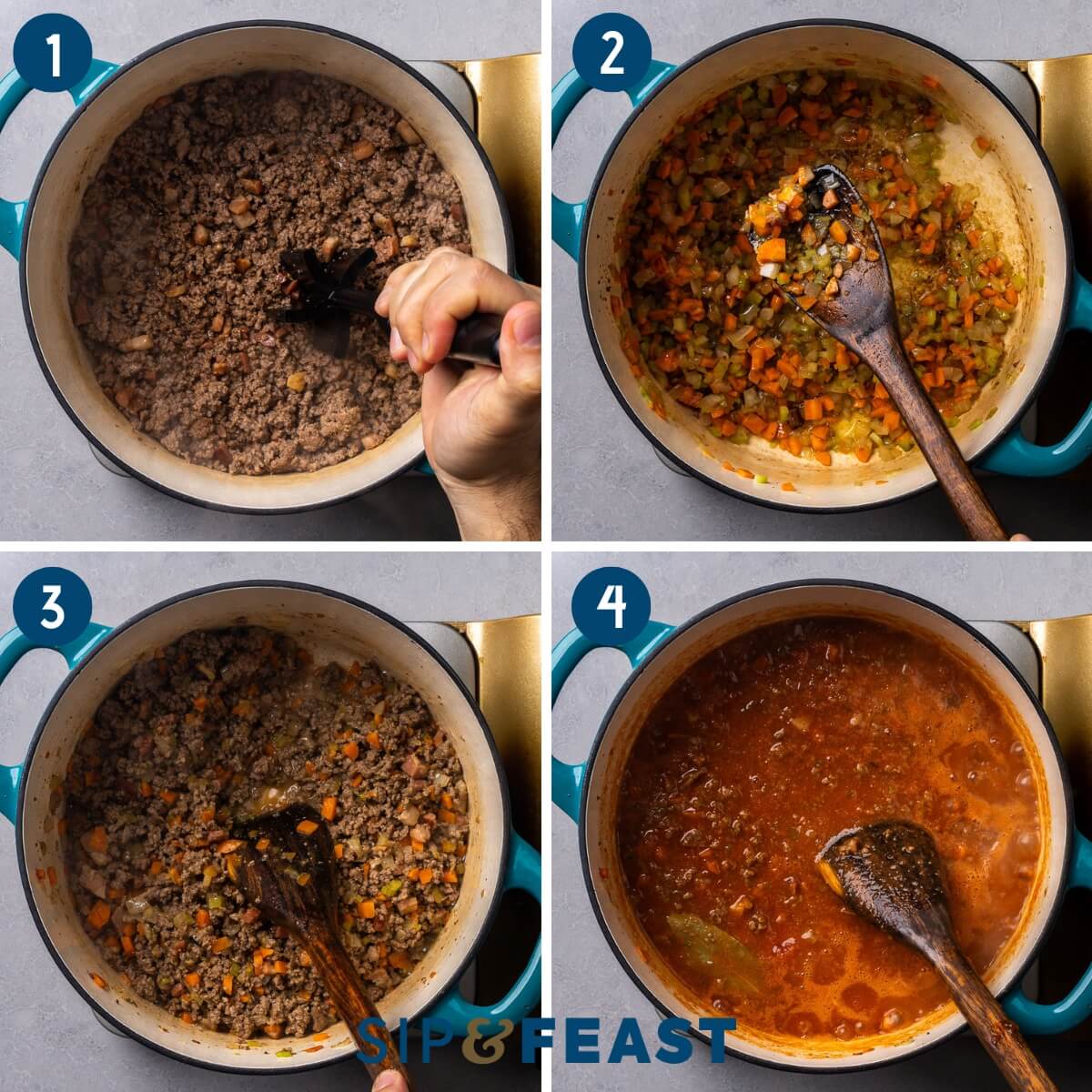
- Add the meat back to the pot along with the wine and use your spoon to dislodge any brown bits.
- Add the stock, half the milk, tomatoes, parmesan rind and bay leaves and bring to a boil.
- Cover with a tight-fitting lid and place in a 300°F oven for 2 1/2 hours, stirring at the halfway point, then uncover and return to the oven for another 30 minutes.
- Add the remaining milk and cream and simmer for 15-30 minutes longer, then taste test and adjust seasoning.
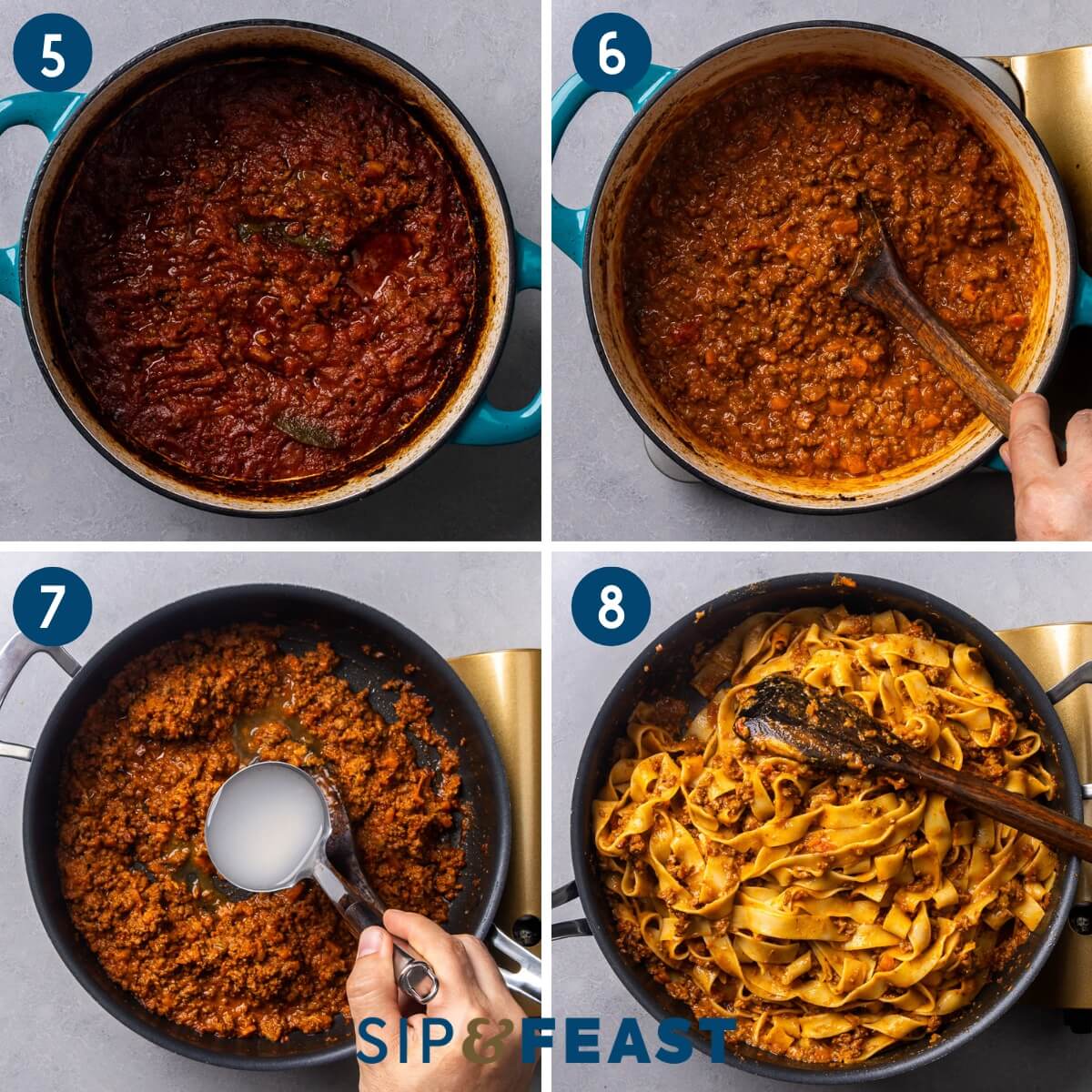
- Begin to cook your pasta in a pot of salted water for 2 minutes less than al dente. Add 3 cups of the Bolognese ragu to a separate saucepan over medium-low heat along with 1/2 cup of pasta water.
- Add the almost-cooked pasta to the pan with the Bolognese sauce and toss to combine. Add a pinch of nutmeg and serve with Parmigiano Reggiano.
Top tips
- Make the ragu ahead. While it’s tempting to eat the Bolognese right away, you’ll be rewarded with extra flavor if you can wait until the next day to eat it. If doing that, do not cook the pasta until right before you plan to eat.
- Adding the nutmeg. This spice can be overpowering. For that reason, I start with a pinch at the very end. You can serve more on the table for those who’d like a little more.
- Use homemade stock. Whenever possible, use homemade beef stock. The flavor is unmatched to store-bought, and it gives you greater control over the sodium levels in your dish.
More hearty pasta recipes
If you love Pappardelle Bolognese, give these other recipes a try!
If you’ve enjoyed this Pappardelle Bolognese recipe, give it a 5-star rating.
Watch us on YouTube, follow along on our Facebook Page, and become a Patreon member to receive access to exclusive full-meal videos and content.
Pappardelle Bolognese
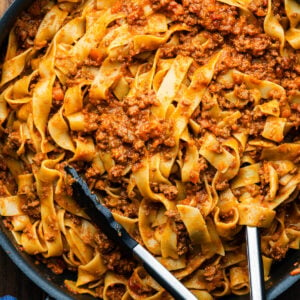
Ingredients
- 1 pound (454g) pappardelle or tagliatelle
- 1/3 pound (150g) pancetta
- 1 1/2 pounds (680g) ground chuck
- salt and pepper to taste
- 2 ribs celery finely diced
- 1 large carrot finely diced
- 1 medium onion finely diced
- 3 anchovy fillets optional
- 1 cup (240ml) dry white wine
- 1 1/2 cups (360ml) low-sodium beef stock
- 1 28-ounce can plum tomatoes hand crushed or blender pulsed
- 1 parmesan rind
- 2 large bay leaves
- 1/2 cup (120ml) milk
- 1/4 cup (60ml) heavy cream
- 1 pinch nutmeg
- 1 cup (240ml) reserved pasta water will most likely not need it all
Want To Save This Recipe?
Instructions
- Preheat the oven to 300°F.
- Heat a large Dutch oven or heavy pot to medium heat with the pancetta. Cook the pancetta until most of the fat has rendered (about 7-10 minutes). Add in ground beef and saute until brown (about 7-10 minutes) while breaking it up with a wooden spoon or meat masher. Season the beef with a bit of salt and pepper.
- Remove the meat with a slotted spoon to a plate and set aside. Add the vegetables and anchovies to the pot along with a pinch of salt and saute until very soft (about 12-15 minutes). Add a splash of water and/or turn down the heat if the vegetables start to burn.
- Add the meat back to the pot along with the wine and turn the heat to high. Scrape the bottom of the pot with a wooden spoon to dislodge any brown bits. Once the wine evaporates add the beef stock, half the milk, crushed tomatoes, parmesan rind, and bay leaves and bring to a boil.
- Once boiling turn off the heat and cover with a tight fitting lid. Place the pot into the oven and cook for 2 1/2 hours, stirring at the halfway point and adding a touch more stock if the pot is too dry. After 2 1/2 hours, remove the lid and return to the oven for another 30 minutes. Note: you can cook the bolognese on the stovetop with very low heat just make to check every so often for burning.
- After 3 hours the fat from the meat and the pancetta will float to the top and the ragu will have thickened somewhat. Add the remaining milk and optional cream and stir to combine. Cook on the stovetop at a simmer for 15-30 minutes more. Make sure to taste test and season with more salt and pepper if required.
- Bring a large pot of salted water to boil and cook the pappardelle until 1-2 minutes less than al dente. Reserve 1 cup of pasta water.
- To sauce the pasta add 3 cups of the bolognese ragu and a 1/2 cup of pasta water to a pan over medium-low heat, then add in the 'less than al dente' pasta and cook until al dente while tossing or moving with tongs so that the pasta can absorb the sauce. Add extra sauce as required. Add a pinch of nutmeg and serve with grated Parmigiano Reggiano cheese. The leftover ragu can be served at the table or saved for another use. Enjoy!
Notes
- Serving. Makes 4 large portions or 6 smaller sized ones.
- Milk/Cream. When using fresh pasta only milk is needed. For dry use the extra 1/4 cup of cream.
- Sauce. Saucing the pasta in the pan is optional, but preferred, as the sauce tends to slide off otherwise.
- Overnight Tip. Cooking the sauce the day before adds a tremendous amount of flavor upon reheating the next day.
- Pasta shape. Flat wide noodles such as pappardelle, fettuccine and tagliatelle work best with the heavy ragu.
- Leftovers. Pappardelle Bolognese can be saved for up to 3 days in the fridge and can be frozen for up to 6 months.
Nutrition
Nutrition information is automatically calculated, so should only be used as an approximation.
Follow Me
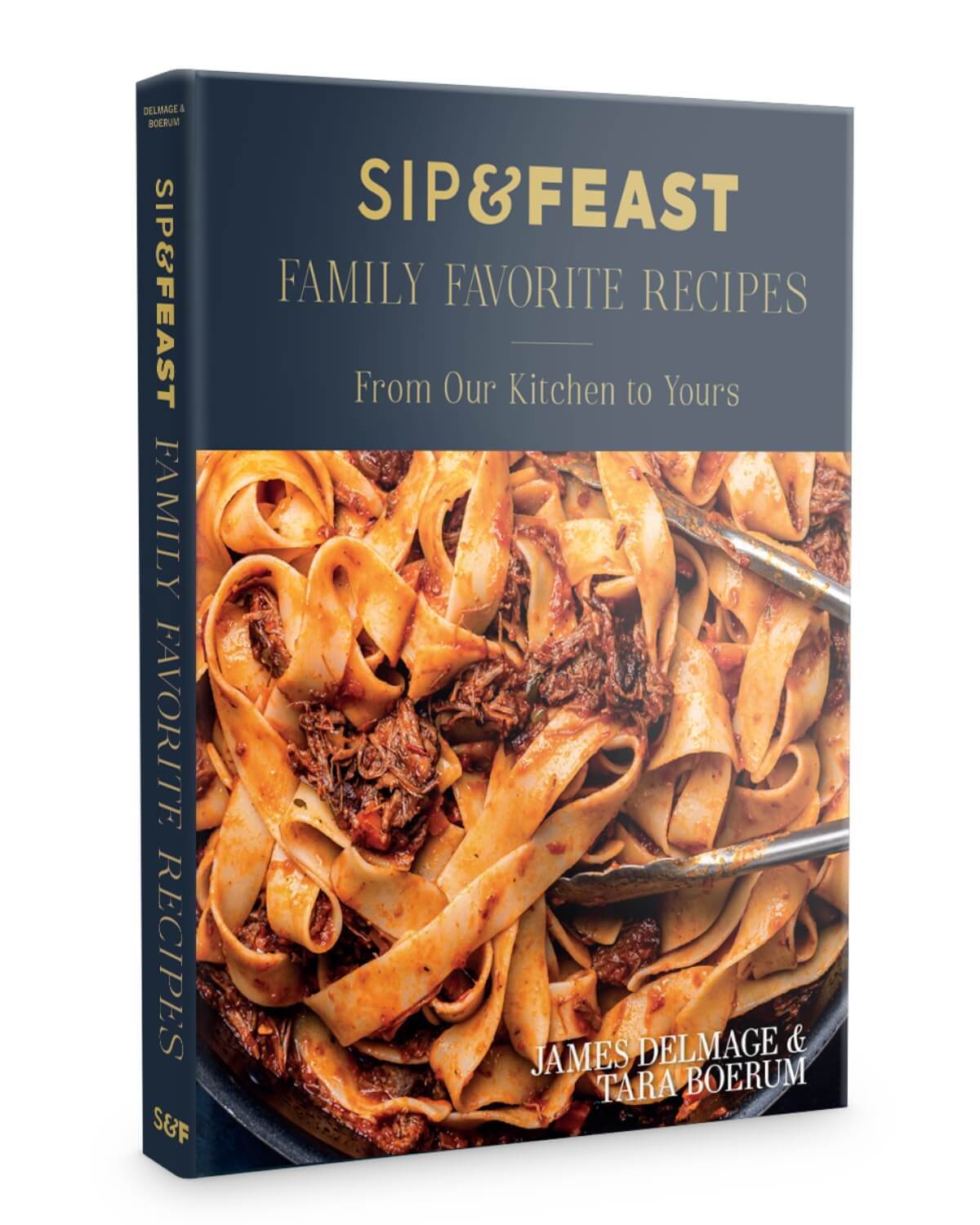
The Sip and Feast Cookbook
- 100+ recipes
- Essential tools and ingredients
- Entertaining ides
- Stunning photography
This recipe was originally published on September 17, 2019. It was completely updated on June 16, 2025.









I made this tonight. VERY good. I only knocked a star off due to the ratio of noodle to sauce. It needed more noodles to the sauce (easily done by buying another box/bag). But SOOOO good.
Is there anyway for you to post your older recipe? I’ve made that one so many times and absolutely loved it. I’m sure the new additions add to it but I’d love to see the original if possible 🙂
Hi Rachel, you can watch Jim make the old recipe in the old YouTube video (also you can find the recipe in the description there). https://youtu.be/I_kzScYEOAI
Can this be made in a crockpot after step 4 ? That would free up a burner on the stove.
Yes you can, though we haven’t made it in a crockpot so can’t advise on timing, etc.
Has anyone ever doubled the recipe and achieved the same results?
I do believe your recipe is missing the ground pork
I will be making your recipe this weekend and I’ll let you know my ranking
Thanks
The recipe here on the website uses ground chuck only (1 1/2 pounds). The one in our cookbook, and the one on our YouTube channel uses a combination of ground chuck and ground pork (3/4 pound of each). That being said, we encourage you to use whichever combination you’d prefer.
Turned out wonderful. Can’t wait to have the left overs.
I made this bolognese yesterday, let it sit overnight, and am enjoying it tonight for dinner, and LOVE it so much! It definitely is a bit of work, but well worth it in the end. I have loved every Sip and Feast recipe I’ve ever tried, and I will definitely be making this again the deeper into winter we get. Warm, filling, and delicious with a wonderful depth of flavor.
So glad you enjoyed!
I have 1 pound ground beef 80/20and half pound ground pork I would like to use both . I recently learned that I get a good result from substituting local bacon for prosciutto turned out pretty nice in another recipe . Question ca I use both a little bit of ground pork and a little bit of bacon? Your friend in the wilds of Montana and cattle country All our meat is raised here younger generations are cleaning up the soil,water and process. Come visit us soon! Thank you for your good work!
You can absolutely use the ground pork and bacon here. Hope you enjoy!
I’ll be making this for the first time this Wednesday for a Thursday dinner. (And I can’t wait to taste it 😄) What’s the best way to heat it back up for maximum flavor?
Hi Gabriel, reheat the sauce on the stove top and make the pasta right before you plan to serve it.
AWESOME. Thank you. Love your videos. Substituted guanciale for panchetta and was very rich and creamy.
So happy you enjoyed, Glen!
A great bolognese! Loved the addition of anchovies (I used anchovy paste from tube) and I had plenty of leftover sauce to freeze. I would love to see you do a lasagna bolognese recipe in the future, will stay tuned
We’re glad you enjoyed this one, and yes, lasagna bolognese is on our list of to-dos.
I made this recipe exactly according to the recipe except I didn’t have anchovies nor a parmesan rind but it was still absolutely delicious! It takes a while to cook so start early and then let it sit for a while! Leftovers were even better as James said they would be!
We’re so happy you enjoyed, Shannon!
Absolutely Delicious!
I actually made this the 3rd time and I was short on hand with a few things so I added 1/2 red and 1/2 white wine and I fried 6oz of fatty bacon and got a lot of rendered fat. Followed the rest and my husband said this is so incredibly good you don’t need pasta,, well he will eat the pot if I don’t make some so of course I did. I started this at 9am and we’ll eat at 4..A salad and Damn it !!! I don’t have the right pasta so I’m using Dececco Fettucine.. I guess whatever works! I have a mexican neighbor who is insane over italian food so he’s invited. Thanks a million again and again.. You Rock..!!
We’re so happy you enjoyed, Patty!
I have made this a dozen times already, and it’s the best I’ve ever had. I had dinner at a local “famous” Italian restaurant recently where my boyfriend ordered bolognese. He looked at me and said “yours is better”… I know!
I make MINOR adjustments. I add the veggies into a food processor until it’s almost a paste. I use 1lb chuck and 1/2 lb ground pork. I also add about a tablespoon of tomato paste once the veggies are done.
Once, I didn’t have pancetta and used bacon instead. It was still just as good. Hats off to you! This recipe is DELICIOUS
We are so happy you feel that way, Allison! Thanks for the comment!
I knew this would be excellent and it was. Thank you once again for a superb recipe. Can’t wait to try the pappardelle with short ribs.
So glad you enjoyed, Cathy!
Heavy or not,
Here I come.
Super tasty
We’re so happy you enjoyed, Clare!